#thyreus
Text

Neon Cuckoo Bee (Thyreus nitidulus), family Apidae, Australia
photograph by Vengolis
2K notes
·
View notes
Video
“ Cuckoo bee “ // rewilding suburbia
Thyreus waroonensis in search of amegilla nesting burrows
Music: Gibran Alcocer - Idea 22
#Lake Coogee#Western Australia#Australia#wildlife#insects#olitarybees#cuckoobee#thyreus#bluebandedbee#amegilla#reel#reels#explore#follow#discover
4K notes
·
View notes
Photo

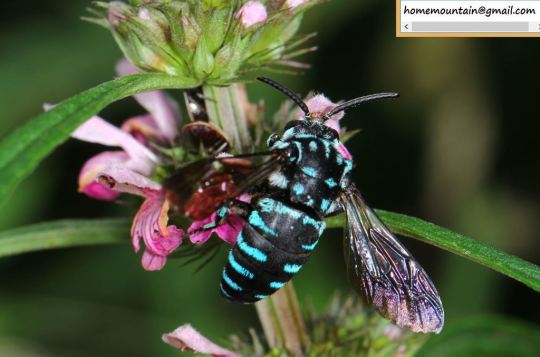
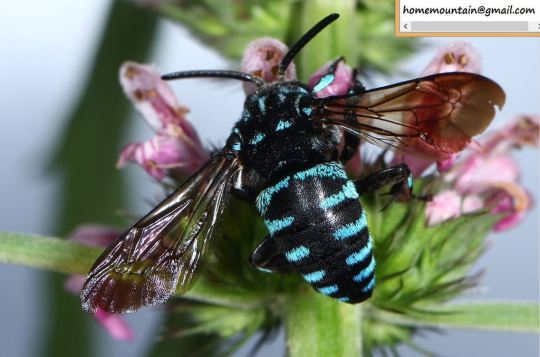

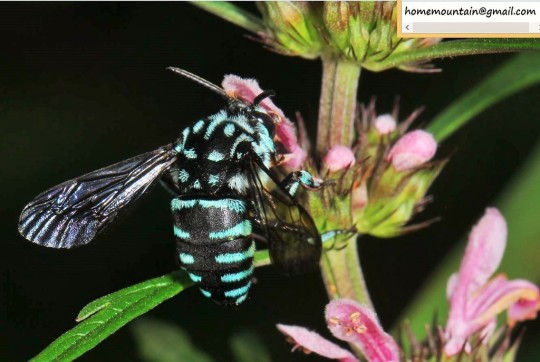

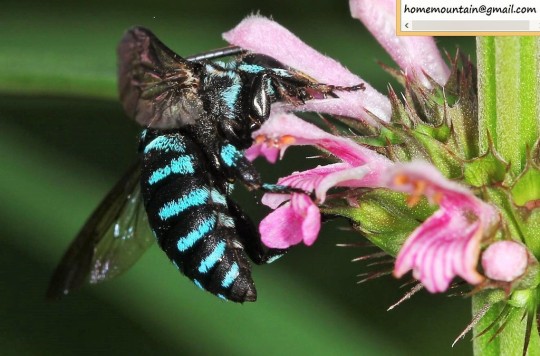



Decorated cloak-and-dagger bee, Thyreus decorus, Apinae
Species in the genus Thyreus are cleptoparasitic cuckoo bees, meaning they lay their eggs in the nests of other bees. Once it hatches, the larva will eat food stores meant for the host larva, and sometimes the host larva itself. Found in Asia.
Photos 1-7 by homemountain, 8 by ming_de, and 9-10 by harumkoh
#animals#curators on tumblr#insects#bugs#bee#cuckoo bee#decorated cloak and dagger bee#Thyreus#cleptoparasite#parasitoid#parasite#bug death#mentioned#predation#one nice bug
2K notes
·
View notes
Text

Neon cuckoo bee! 🐝 This striking local native bee (Thyreus nitidulus) has an incredible pattern of bright metallic blue patches along its body and legs. 💙
#art#my art#digital art#digital artist#traditional art#traditional artist#mixed media#digital and traditional#artists on tumblr#insect#bee#bees#insects of tumblr#insects#save the bees#native bees#neon cuckoo bee#thyreus nitidulus#australian artist#australia
4 notes
·
View notes
Text



let him hide from conversations or he is going to make it everyone elses problem
1 note
·
View note
Text
The Oriental Blue Clearwing Moth: these moths were regarded as a "lost species" for more than 130 years, until they were finally sighted again in 2013
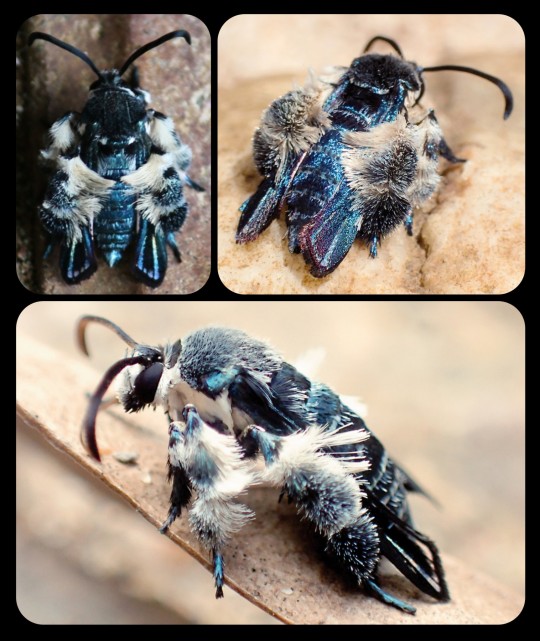
For more than 130 years, the Oriental blue clearwing moth (Heterosphecia tawonoides) was known only from a single, badly damaged specimen that was collected in Sumatra in 1887. There were no recorded sightings of this species again until 2013, when entomologist Dr. Marta Skowron Volponi unexpectedly found the moths feeding on salt deposits that had accumulated along the riverbanks in Malaysia's lowland rainforest.

These moths were observed by researchers again in 2016 and 2017, and research indicates that the moths are actually bee-mimics, as they mimic the appearance, sound, behavior, and flight patterns of local bees. Their fuzzy, bright blue appearance might seem a little out of place for a bee-mimic, but those features do appear in several different bee species throughout Southeast Asia.
When the moths are in flight, they bear a particularly strong resemblance to the bees of the genus Thyreus (i.e. cuckoo bees, otherwise known as cloak-and-dagger bees), several of which are also bright blue, with banded markings, dark blue wings, fuzzy legs, and smooth, rounded antennae. The physical resemblance is compounded by the acoustic and behavioral mimicry that occurs when the moths are in flight.
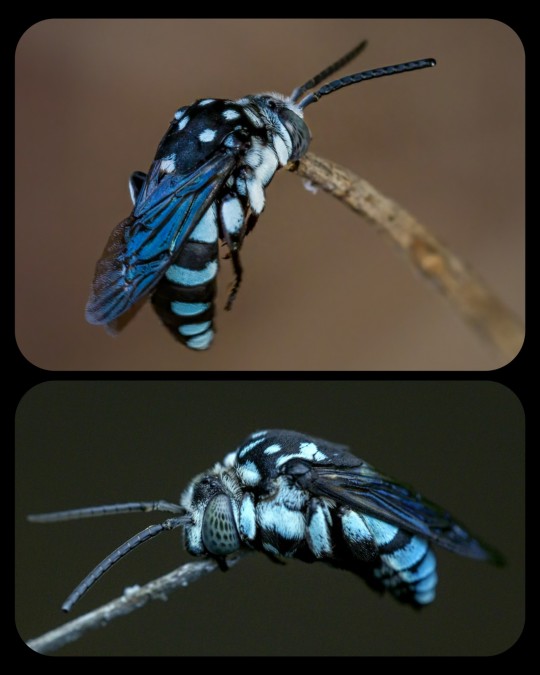
Cloak-and-Dagger Bees: the image at the top shows an Indo-Malayan cloak-and-dagger bee (Thyreus novaehollandiae) in a sleeping position, holding itself upright with its mandibles clamped onto a twig, while the image at the bottom shows a Himalayan cloak-and-dagger bee (T. himalayensis) resting in the same position
The moths also engage in "mud-puddling" among the various bees that congregate along the riverbanks; mud-puddling is the process whereby an insect (usually a bee or a butterfly) draws nutrients from the fluids found in puddles, wet sand, decaying plant matter, carrion, animal waste, sweat, tears, and/or blood. According to researchers, the Oriental blue clearwing moth was the only lepidopteran that was seen mud-puddling among the local bees.
Dr. Skowron Volponi commented on the unusual appearance and behavior of these moths:
You think about moths and you envision a grey, hairy insect that is attracted to light. But this species is dramatically different—it is beautiful, shiny blue in sunlight and it comes out during the day; and it is a master of disguise, mimicking bees on multiple levels and even hanging out with them. The Oriental blue clearwing is just two centimeters in size, but there are so many fascinating things about them and so much more we hope to learn.
This species is still incredibly vulnerable, as it faces threats like deforestation, pollution, and climate change. The president of Global Wildlife Conservation, which is an organization that seeks to rediscover "lost species," added:
After learning about this incredible rediscovery, we hope that tourists visiting Taman Negara National Park and picnicking on the riverbanks—the home of these beautiful clearwing moths—will remember to tread lightly and to take their trash out of the park with them. We also recommend that Americans learn about palm oil production, which is one of the primary causes of deforestation in Malaysia.
Sources & More Info:
Phys.org: Bee-Mimicking Clearwing Moth Buzzes Back to Life After 130 Years
Mongabay News: Moth Rediscovered in Malaysia Mimics Appearance and Behavior of Bees to Escape Predators
Journal of Tropical Conservation Science: Lost Species of Bee-Mimicking Clearwing Moth, H. tawonoides, Rediscovered in Peninsular Malaysia's Primary Rainforest
Frontiers in Zoology: Southeast Asian Clearwing Moths Buzz like their Model Bees
Royal Society Publishing: Moving like a Model - mimicry of hymenopteran flight trajectories by clearwing moths of Southeast Asian rainforests
Medium: Rediscovery in a Glint of Blue
re:wild.org: The "Search for Lost Species" Project
#lepidoptera#moths#heterosphecia tawonoides#oriental blue clearwing moth#entomology#insects#cute bugs#nature#animals#lost species#mimicry#evolution#bees#southeast asia#Malaysia#colorful moths#bee mimic#science
78 notes
·
View notes
Text

Honeytsune Beeku
idea from friends on a discord server, she's based on a thyreus cuckoo bee 🐝💙
13 notes
·
View notes
Text


bee pride flag
red: red-belted bumblebee, bombus rufocinctus (source)
orange: valley carpenter bee, xylocopa varipuncta (source)
yellow: yellow-banded bumblebee, bombus terricola (source)
green: green metallic sweat bee, augochloropsis metallica (source)
blue: neon cuckoo bee, thyreus nitidulus (source)
purple: orchid bee, euglossia sp. (source)
255 notes
·
View notes
Text
Animal spotlight!
Starting off with a personal favourite, we have the cloak-and-dagger bees, genus Thyreus! I'd love to say they're my favourites because they're exceptionally interesting but it is mainly because I find them very cute and beautiful :3 I am not immune. Thyreus histrionicus (David Marquina Reyes) and Thyreus himalayensis (marcelfinlay on iNaturalist)


They are kleptoparasites, meaning that they lay their eggs in other bees' nests so their larvae can feed on pollen collected for the host's larvae, much like a cuckoo (lending various kleptoparasitic bees the title of cuckoo bees). They also often kill and eat their new nestmates.
One of my favourite things about them is their roosting behaviour. They sleep attached to twigs or dead plants by the mandibles! This isn't exclusive to the genus, many solitary bees sleep this way, particularly males. Here, two histrionic cloak-and-dagger bees can be seen roosting alongside some white-banded digger bees, Amegilla quadrifasciata (a species that they parasitise!). Image by David Marquina Reyes

And here is an articulated nomad bee (Nomada articulata, another cuckoo bee) doing the same! Image by jerremie on iNaturalist

3 notes
·
View notes
Text
Espèce nouvelle pour l'Autriche : une abeille sauvage encore jamais vue en Europe centrale vient d'être observée dans deux zones protégées par une association de protection de la nature
See on Scoop.it - EntomoNews

C’est le biologiste Oliver Zweidick qui l’a observée dans deux zones protégées par la Naturschutzbund, l’Association de la conservation de la nature : une pente sablonneuse près de la frontière slovène et une ancienne carrière au nord de la ville de Graz.
Une nouvelle espèce d’abeille sauvage découverte en Autriche
21 décembre 2022 à 18h17
«Le fait qu’elle apparaisse maintenant en Autriche a probablement aussi à voir avec le changement climatique, qui favorise sa propagation», précise le journal autrichien Kleine Zeitung. Jusqu’à présent, seulement cinq espèces du genre d’abeille tachetée étaient connues en Europe."
[Image] L'espèce découverte en Autriche est une Thyreus picaron, littéralement « abeille tachetée cachée ». - Crédit : Naturschutzbund / Lorenz W. Gunzcy
-------
NDÉ
Communiqué
Neue Wildbienenart für Mitteleuropa entdeckt - Naturschutzbund Österreich https://naturschutzbund.at/newsreader-505/items/neue-wildbienenart-fuer-mitteleuropa-entdeckt-5.html
Traduction
Dans le cadre de son assemblée annuelle, le Conseil autrichien pour les abeilles sauvages a présenté les premières preuves de "l'abeille tachetée cachée" en Autriche et l'a élue "découverte d'abeille sauvage la plus importante de l'année". Les découvertes ont été faites par le biologiste Oliver Zweidick sur deux surfaces de l'association de protection de la nature au cours d'un projet de recherche mené dans toute la Styrie.
Jusqu'à présent, on connaissait cinq espèces d' "abeilles tachetées" d'Europe centrale, qui font partie de ce que l'on appelle les abeilles coucous. Elles ne récoltent pas de pollen et ne construisent pas de nids, mais pondent leurs œufs discrètement dans les nids d'autres abeilles sauvages.
Traduit avec www.DeepL.com/Translator (version gratuite)
Pour en savoir plus :
Thyreus est un genre d'abeilles appartenant au groupe fonctionnel des abeilles cleptoparasites, ou plus vulgairement "abeilles coucous". Les femelles parasitent dans le nid d'autres espèces d'abeilles. Les abeilles appartenant au genre Thyreus parasitent des abeilles des genres Anthophora et Amegilla
via Wikipédia, version du 26 avril 2022 à 21:56.
https://fr.wikipedia.org/wiki/Thyreus
Sur sa répartition :
Atlas of the European Bees: genus Thyreus
http://www.atlashymenoptera.net/page.aspx?id=258
0 notes
Text

Neon Cuckoo Bee (Thyreus nitidulus), family Apidae, Australia
photograph by Mark Acal
240 notes
·
View notes
Text
Une nouvelle espèce d’#abeille #sauvage découverte en #Autriche
Elle a un corps noir et des taches blanches poilues : voilà l’abeille qui vient d’être repérée en Styrie, en Autriche. Une verborgene fleckenbiene, littéralement « abeille tachetée cachée » (Thyreus picaron). Une première pour l’Europe centrale, car cette espèce est originaire de la région méditerranéenne. Selon le Conseil autrichien des abeilles sauvages, il s’agit de « la plus importante découverte d’abeille sauvage de l’année ».
Les abeilles sauvages sont parmi les insectes les plus importants. On compte à (...)
0 notes
Text
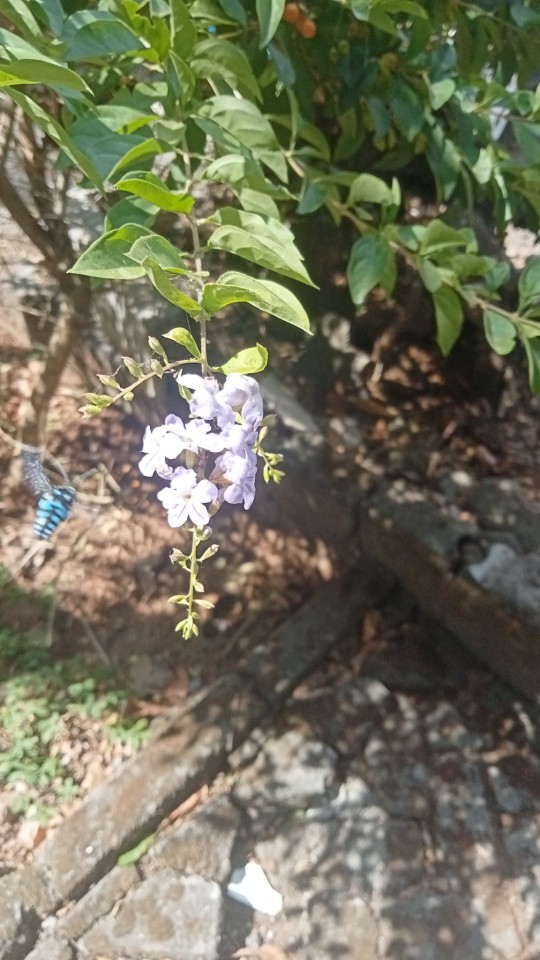
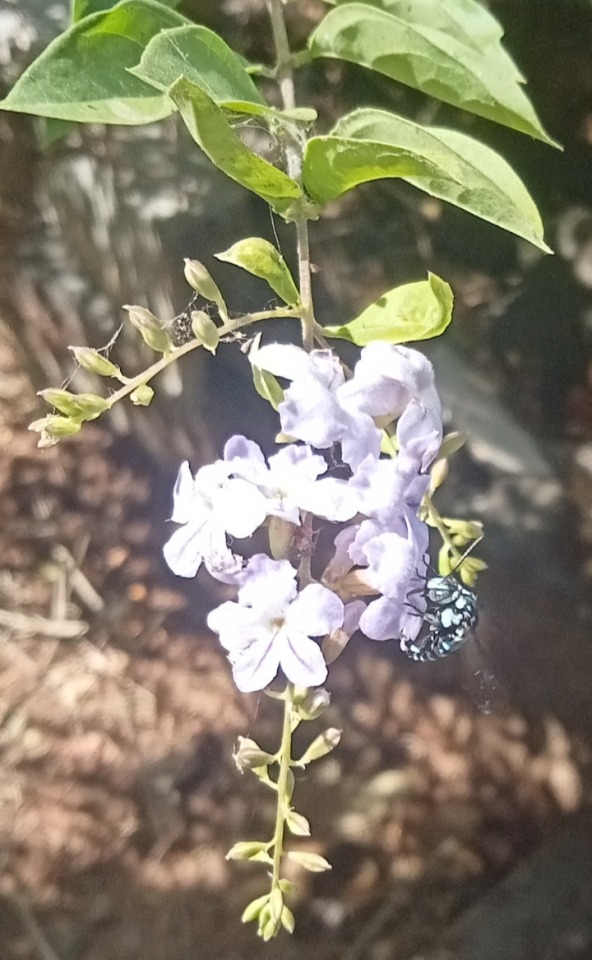

@shindig-shimpalooze submitted: (West Java, Indonesia)
I was taking a picture of these flowers growing in my campus' parking lot when this blue fellow decided it wanted a photoshoot!
Google says it's a type of cuckoo bee, bees that lay their eggs in other bees' nests. Do parasitic bees like these cause a lot of damage to other bee populations or is it negligible? And is the blue we're seeing pigment or structural?
Thanks and sorry for asking so much, love your blog! <3
Looks like a cloak and dagger bee in the genus Thyreus, and yes, cloak and dagger bees are a type of cuckoo bee. Parasites and parasitoids are a very important part of any ecosystem and help keep other species' populations in check. If they decimated the populations of their host entirely, they wouldn't have a host to take advantage of. So it's a delicate balance. I'm afraid I couldn't find whether their blue color is pigment or structural, though!
119 notes
·
View notes
Text




‘Thyreus’ WindstoneEditions kirin. I painted this piece with the colouration of the blue neon cuckoo bee in mind. It’s painted using atelier and folkart metallic acrylics, with antiquing in 2 colours and is sealed with a Uv resistant gloss finish. Sadly the horn had got bent when it originally travelled to me, so I have carefully reshaped it and sealed to protect the gold plating.
NFS, this piece already has a home.
#craft#crafts#animals#maker#kirin#windstones#windstoneskirin#fancykirin#fantasy#figurine#painting#collectiblefigurine#collectible#windstone
0 notes
Text
demon au doze is trying to make a good enough human disguise

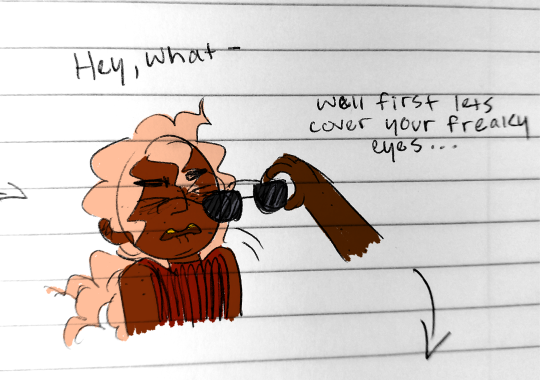

he didnt realize light isnt supposed to hurt
bonus:
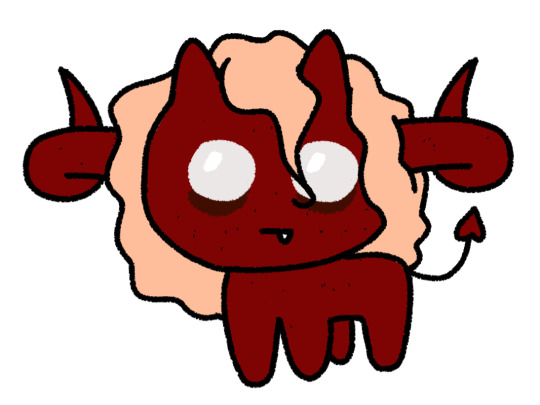
1 note
·
View note
Photo
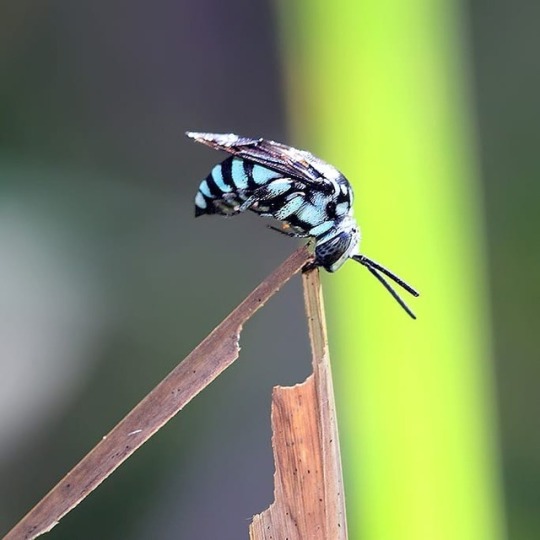
Thyreus decorus #cuckoobee #bee #bluebee #thyreus #insectmagazine #instainsect #insectagram #insect #insects_macro #macrophotography #macropicture #macro #macroworld #natureofthailand #naturephotography #nature #biodiversity
#naturephotography#macrophotography#insects_macro#macroworld#macropicture#macro#biodiversity#natureofthailand#insect#cuckoobee#bluebee#thyreus#nature#instainsect#insectagram#bee#insectmagazine
2 notes
·
View notes